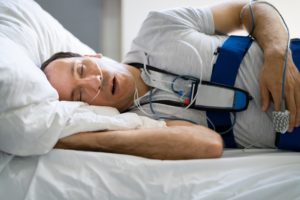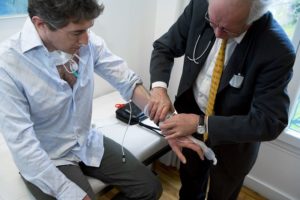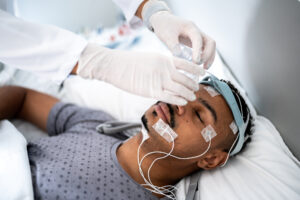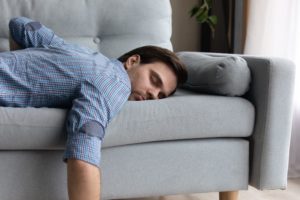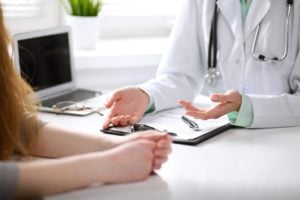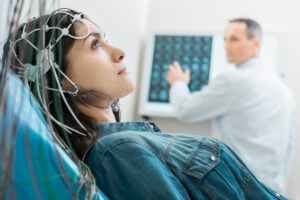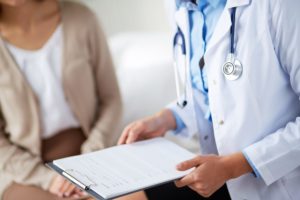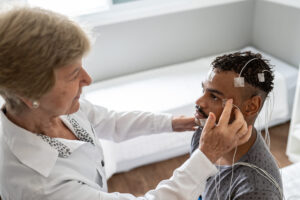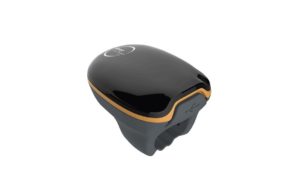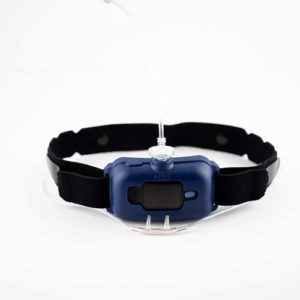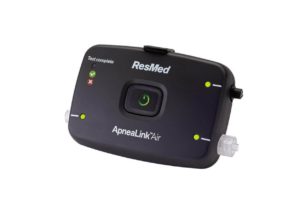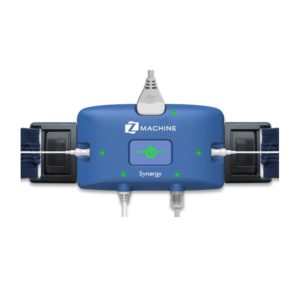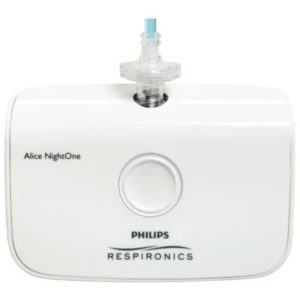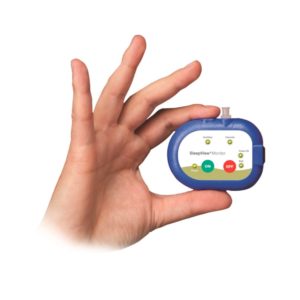Actigraphy
Actigraphy is a type of wearable sleep test that tracks your movements to analyze when you are asleep and when you are awake. This device can help doctors diagnose certain sleep disorders and monitor the treatment progress of people who have already been diagnosed with a disorder.
How Does Actigraphy Work?
An actigraphic device looks similar to a wristwatch and is typically worn on the wrist or the ankle. Its basic components include an accelerometer that records movement, a data storage unit, and a programmable timing mechanism.
The data collection process is usually performed over at least several days and often several weeks. Actigraphy is designed to provide minimal interference to day-to-day life, so you can go about your normal routine.
What Does Actigraphy Measure?
Based on your movements, actigraphy attempts to calculate sleep parameters such as:
- What time you fall asleep
- What time you wake up
- How long you take to fall asleep
- How long you sleep in total
- How much time you spend awake during the night after having fallen asleep
These parameters help medical professionals identify any peculiarities in your sleep schedule. Actigraphy may be used on its own, or in combination with another sleep test such as a sleep log or an overnight sleep test.

What Is Actigraphy Used For?
Actigraphy relies on interpreting movements, so it can only be used in the context of certain sleep disorders. The American Academy of Sleep Medicine currently acknowledges the potential benefits of using actigraphy for people with the following sleep disorders:
- Insomnia: People with insomnia tend to have irregular sleep and wake times, and they often underestimate or overestimate their total sleep time. Together with a sleep log, actigraphy can help establish total sleep time and identify how long it takes a person to fall asleep on average, over a period of several weeks.
- Circadian Rhythm Sleep-Wake Disorders: Circadian rhythm sleep-wake disorders occur when a person’s sleep-wake schedule falls out of alignment with regular day-night patterns. Actigraphy provides a picture of sleep patterns over multiple days and nights, so doctors can create an appropriate treatment plan.
- Sleep Apnea: The best way to diagnose sleep apnea is with an overnight sleep test in a laboratory, but this can be cost-prohibitive and inconvenient. Sometimes, doctors may prefer to use a home sleep apnea test. To supplement the home sleep apnea testing equipment, actigraphy can provide information about the total sleep time so doctors can know what proportion of sleep time is occupied by lapses in breathing.
- Insufficient Sleep Syndrome: Actigraphy can be used to identify the total sleep time of people who may have insufficient sleep syndrome.
- Multiple Sleep Latency Test: Excessive sleepiness, also called hypersomnolence, is usually diagnosed using the Multiple Sleep Latency Test, which examines how easily a person falls asleep during the day. In the days leading up to the test, doctors may ask you to wear an actigraphy watch so they can ensure you do not arrive to the lab sleep-deprived, which would affect the test results.
Researchers have also considered using actigraphy to diagnose periodic limb movement disorder, in which the limbs move during sleep. However, actigraphy on its own generally does not produce accurate results, and it is not recommended for this purpose.
Actigraphy may be useful for monitoring treatment of insufficient sleep syndrome and treatment of sleep disorders in children, though more research is needed. It appears that many people adhere better to the sleep routine prescribed by their doctor if they know that an actigraphy watch is monitoring their actions.
What to Expect From an Actigraphy Test
Actigraphy is a simple process that requires little to no preparation. The actigraphy watch usually goes on your non-dominant wrist and it should not be covered with clothing. Your doctor instructs you on how to use it, how long you need to wear it, and how to troubleshoot any problems that might come up. Once you have finished collecting the data, you return the device to your doctor, who uploads the data into the computer for interpretation.
You should wear the actigraph device at all times except when it isn’t possible. For example, you may be able to wear the actigraphy watch in the shower, but if it is not fully waterproof, you can’t wear it in the swimming pool. You may also need to remove it while playing sports. Keep track of the times when you take the watch off and put it back on.
Actigraphy is fairly accurate at interpreting some measures, but not as accurate at interpreting others. For example, if you lay still in bed for an hour trying to fall asleep, the actigraphy might interpret that period as sleep. To better understand discrepancies in the data, your doctor may ask you to also keep a sleep diary, or sleep log, in which you track:
- Your bedtime and wakeup time
- How long you slept for in total
- How many times you woke up throughout the night, and for how long
- Whether you took any sleep aids before sleeping
- Whether you took any naps
- If your sleep schedule was different that day due to a specific reason
- If you traveled across time zones
The sleep diary also provides a backup in case the actigraphy malfunctions or you need to take it off.
Some actigraphic devices have additional features, such as an event marker button that you can press to mark your wakeup time, or a button that you can press to confirm that you are awake when you are lying still. The watch may also have a light sensor, which can reveal whether someone’s sleep problems might be due to an overly bright bedroom or insufficient light during the day.
How Does Actigraphy Compare to Other Methods for Evaluating Sleep?
Actigraphy is generally considered more accurate than a sleep log and less accurate than polysomnography , which is an overnight test in a sleep laboratory that measures electrical brain activity and other biological parameters, such as breathing and oxygen levels.
Because it is movement-based, actigraphy is quite accurate at identifying how long healthy people sleep , but less accurate when evaluating fragmented sleep, reduced sleep time overall, long periods of trying to fall asleep, or restless sleep.
Each sleep test method has benefits and drawbacks in terms of accuracy, convenience, and cost. To compensate for any shortfalls, two or more tests are often used together .
Actigraphy
While actigraphy may not provide the most detailed information, it offers a broad overview for sleepers and is easy to use.
| Accuracy | Convenience | Cost |
|---|---|---|
| -Does not measure sleep stages -Relies on movement and may overestimate sleep for some people -Less accurate for people with limited mobility -Data is more representative of the person’s usual habits, and data is collected over multiple days and nights -Useful for measuring nighttime awakenings in children | -Easy to complete for most people -Simple to interpret, even if you are not a medical professional -Technological malfunctions possible but rare -Minimally invasive -Must be worn all day and all night -Wristband may aggravate sensitive skin | -Affordable, though more expensive than a sleep diary -May not be covered under insurance |
Polysomnography
Polysomnography offers thorough information for medical professionals to evaluate, but the results may be affected by having to sleep in a lab.
| Accuracy | Convenience | Cost |
|---|---|---|
| -Generally considered the most accurate test, as it measures sleep stages based on brain waves -Vulnerable to the first night effect, in which a person may sleep differently in a lab than at home -Difficult for children or those with special needs | -More inconvenient, as full polysomnography can only be performed in a sleep lab | -Relatively expensive |
Sleep Log
A sleep log is a simple, affordable way to track sleep habits, but it requires consistency. Results can also be affected by how the sleeper feels about their rest.
| Accuracy | Convenience | Cost |
|---|---|---|
| -Captures the sleeper’s subjective experience -Does not measure sleep stages | -Requires some diligence in filling out every day -Simple to fill out, but may be impractical for children or people with cognitive impairment | -Negligible cost |
Where to Get Actigraphy Assessment
If an actigraphy assessment is appropriate for your situation, your doctor or sleep specialist will provide an FDA-approved device and work with you to carry out testing.
You may have seen commercially available wearable products, such as smart watches or Fitbits , marketed with claims that they provide information about sleep parameters by measuring movement, heart rate, and other features . Currently there is not enough research to approve these commercial products as diagnostic or treatment tools, though they may provide helpful additional information about your sleep habits.

Still have questions? Ask our community!
Join our Sleep Care Community — a trusted hub of sleep health professionals, product specialists, and people just like you. Whether you need expert sleep advice for your insomnia or you’re searching for the perfect mattress, we’ve got you covered. Get personalized guidance from the experts who know sleep best.
References
12 Sources
-
Martin, J. L., & Hakim, A. D. (2011). Wrist actigraphy. Chest, 139(6), 1514–1527.
https://pubmed.ncbi.nlm.nih.gov/21652563/ -
Smith, M. T., McCrae, C. S., Cheung, J., Martin, J. L., Harrod, C. G., Heald, J. L., & Carden, K. A. (2018). Use of actigraphy for the evaluation of sleep disorders and circadian rhythm sleep-wake disorders: An American Academy of Sleep Medicine systematic review, meta-analysis, and GRADE assessment. Journal of Clinical Sleep Medicine: JCSM: Official Publication of the American Academy of Sleep Medicine, 14(7), 1209–1230.
https://pubmed.ncbi.nlm.nih.gov/29991438/ -
Smith, M. T., McCrae, C. S., Cheung, J., Martin, J. L., Harrod, C. G., Heald, J. L., & Carden, K. A. (2018). Use of actigraphy for the evaluation of sleep disorders and circadian rhythm sleep-wake disorders: An American Academy of Sleep Medicine clinical practice guideline. Journal of Clinical Sleep Medicine: JCSM: Official Publication of the American Academy of Sleep Medicine, 14(7), 1231–1237.
https://pubmed.ncbi.nlm.nih.gov/29991437/ -
Lam, J. C., Mahone, E. M., Mason, T. B., & Scharf, S. M. (2011). Defining the roles of actigraphy and parent logs for assessing sleep variables in preschool children. Behavioral Sleep Medicine, 9(3), 184–193.
https://pubmed.ncbi.nlm.nih.gov/21722013/ -
Keller, M., Roth, W. T., & Petrowski, K. (2020). Supplementing sleep actigraphy with button pressing while awake. PLoS One, 15(6), e0234060.
https://pubmed.ncbi.nlm.nih.gov/32555652/ -
Marino, M., Li, Y., Rueschman, M. N., Winkelman, J. W., Ellenbogen, J. M., Solet, J. M., Dulin, H., Berkman, L. F., & Buxton, O. M. (2013). Measuring sleep: Accuracy, sensitivity, and specificity of wrist actigraphy compared to polysomnography. Sleep, 36(11), 1747–1755.
https://pubmed.ncbi.nlm.nih.gov/24179309/ -
Withrow, D., Roth, T., Koshorek, G., & Roehrs, T. (2019). Relation between ambulatory actigraphy and laboratory polysomnography in insomnia practice and research. Journal of Sleep Research, 28(4), e12854.
https://pubmed.ncbi.nlm.nih.gov/30941838/ -
Ibáñez, V., Silva, J., & Cauli, O. (2018). A survey on sleep assessment methods. PeerJ, 6, e4849.
https://pubmed.ncbi.nlm.nih.gov/29844990/ -
Asgari Mehrabadi, M., Azimi, I., Sarhaddi, F., Axelin, A., Niela-Vilén, H., Myllyntausta, S., Stenholm, S., Dutt, N., Liljeberg, P., & Rahmani, A. M. (2020). Sleep tracking of a commercially available smart ring and smartwatch against medical-grade actigraphy in everyday settings: Instrument validation study. JMIR mHealth and uHealth, 8(10), e20465.
https://pubmed.ncbi.nlm.nih.gov/33038869/ -
Lee, X. K., Chee, N. I., Ong, J. L., Teo, T. B., van Rijn, E., Lo, J. C., & Chee, M. W. (2019). Validation of a consumer sleep wearable device with actigraphy and polysomnography in adolescents across sleep opportunity manipulations. Journal of Clinical Sleep Medicine: JCSM: Official Publication of the American Academy of Sleep Medicine, 15(9), 1337–1346.
https://pubmed.ncbi.nlm.nih.gov/31538605/ -
Roberts, D. M., Schade, M. M., Mathew, G. M., Gartenberg, D., & Buxton, O. M. (2020). Detecting sleep using heart rate and motion data from multisensor consumer-grade wearables, relative to wrist actigraphy and polysomnography. Sleep, 43(7), zsaa045.
https://pubmed.ncbi.nlm.nih.gov/32215550/ -
Khosla, S., Deak, M. C., Gault, D., Goldstein, C. A., Hwang, D., Kwon, Y., O’Hearn, D., Schutte-Rodin, S., Yurcheshen, M., Rosen, I. M., Kirsch, D. B., Chervin, R. D., Carden, K. A., Ramar, K., Aurora, R. N., Kristo, D. A., Malhotra, R. K., Martin, J. L., Olson, E. J., … American Academy of Sleep Medicine Board of Directors (2018). Consumer sleep technology: An American Academy of Sleep Medicine position statement. Journal of Clinical Sleep Medicine: JCSM: Official Publication of the American Academy of Sleep Medicine, 14(5), 877–880.
https://pubmed.ncbi.nlm.nih.gov/29734997/



